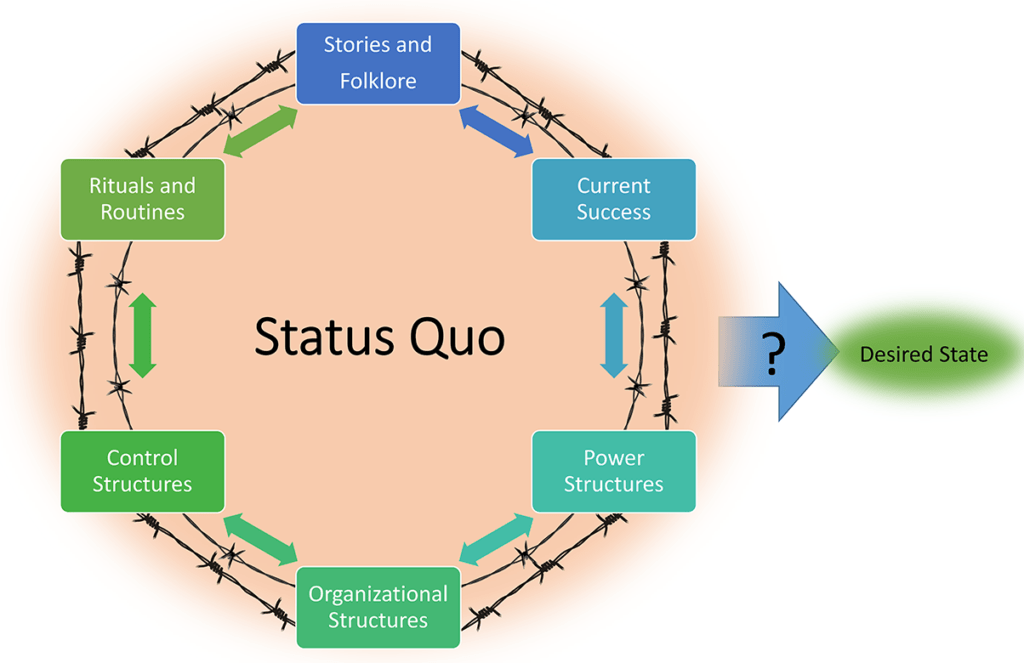I just got off a call with another transformation coach who said his company is moving away from its transformation work, and they are going to be reverting to the basics that built their company 20 years ago. My sarcasm got the best of me, and I shouted out, “You mean IBM typewriters and inter-office mail?” We both got a good laugh, and it helped to release some of the stress that was on the phone call.
The reality is that my friend was experiencing what happens to about 70-80% of the Agile adoptions in our industry. In his case, regardless of how well the transformation was going, the power structure within the company chose to fall back to the nostalgia of success-of-days-gone-past with the hope that this would be the silver bullet that would fix the woes of today’s business realities.
As we talked more about the successes they had achieved through the transformation, it became clear that the adoption of the new rituals and routines had done some great things. Nobody could deny that the company was delivering faster and with higher quality, but the work my friend was describing was not transformation work. He fell into the trap of thinking that the adoption of SAFe and Scrum was transforming his business when in reality it was only changing how his development team did its work. More importantly, the work of his team was doing little to address the meta-goal of any business transformation effort–that is neutralizing the almighty status quo!

The status quo is the neutron star of complexity and gravity that most of your organization has a vested interest in maintaining. That is why the gravity that holds it together is so strong. Anything from bonuses, organizational structures, governance, and daily routines are designed to maintain it. Add to that the great stories of how our current success has everything to do with today’s status quo; it continues to pull us away from the desired state of what started our transformation in the first place.
So how do we defeat the status quo that is holding things so tightly in place? Well, we can’t directly. If we attack it directly, then so many things defending it will kick and fight back. Instead, we need to neutralize the things that are holding it in place. The first starting point is to reinforce the reasons why we need to move away from our current state. We need to create a sense of urgency around how staying in our status quo would be detrimental to all of us.
Andy Grove, the late co-founder of Intel Corporation, was great at this. I had the benefit of working 32 years at Intel, and I had the privilege of working with Andy firsthand. I have seen the way he would use a company crisis to shift us out of our comfort zones. I am not going to try in this blog post to go into that in detail, but I do invite you to read his book Only the Paranoid Survive: How to Exploit the Crisis Points That Challenge Every Company. (Affiliate Link) I have said for years, never waste a good crisis when we are doing transformation work. In the chaos that crises bring, we become very motivated to change.
But what if we are not in crisis yet?
I feel the more significant question is how to move people when we are not at a time of crisis. Company leadership needs to be involved in all aspects of transformation work that is going on in your business. Their job is to continue to pound the drum of why this is important. Now that opens the question of how to bring all your leaders in line with this. Remember, some of them were hired to maintain the status quo, and they may not be very willing to end the current way of things. This is where “beneficial attractors” come into play.
In a complex environment, we need to establish something that attracts leaders to the new way we want things to be done. We also need to dampen things that may hold them in their current state. In the case of leadership, perhaps we can change the reward system so that people who get promotions or bonuses are the ones who help to support the transformation in some way. On the opposite side, we lower or remove the rewards for defending the status quo.
Perhaps, you can also publish more stories in your internal newsletter about leaders and teams that do more to support the transformation work within the company. Again, on the flip side, we lower or don’t publish any stories about things that support the status quo. Doing this starts to shift how the leadership behaves and that in turn begins to change the power structure away from defending the status quo.
Keep in mind that we do have other areas to address the governance system and other control structures that we may have in our company. We also have things to do in the way our overall company is structured as well. But, with leadership now in better alignment, we are not going to have one or multiple parts of our administration derailing our transformation work, like what happened to my friend in the opening of this blog post. And saving us from having to refit our office with IBM Selectric typewriters
As always, please reach out and let me know what you think of this post. I hope to see you at deliver:Agile, Agile 2018, or at one of the other events I am attending this year.
–Ray











